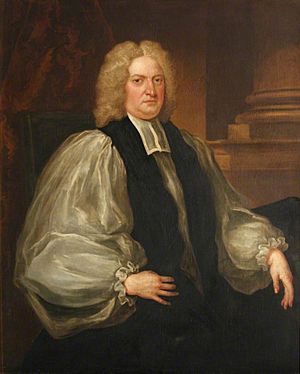Edmund Gibson facts for kids
Quick facts for kids The Right Reverend and Right Honourable Edmund Gibson |
|
|---|---|
| Bishop of London | |

Edmund Gibson by John Vanderbank
|
|
| Church | Church of England |
| Diocese | Diocese of London |
| Elected | 1723 |
| Reign ended | 1748 (death) |
| Predecessor | John Robinson |
| Successor | Thomas Sherlock |
| Other posts | Bishop of Lincoln 1716–1720 Archdeacon of Surrey 1710–1716 |
| Orders | |
| Consecration | c. 1716 |
| Personal details | |
| Born | 1669 Bampton, Westmorland |
| Died | 6 September 1748 |
| Buried | All Saints Church, Fulham |
| Nationality | British |
| Denomination | Anglican |
| Profession | Latin scholar |
| Alma mater | Queen's College, Oxford |
Edmund Gibson (1669–6 September 1748) was an important British church leader. He was a bishop in the Church of England, serving as the Bishop of Lincoln and later the Bishop of London. He was also a legal expert and someone who studied old things, known as an antiquary.
Contents
Early Life and Start of His Career
Edmund Gibson was born in a place called Bampton in Westmorland in 1669. In 1686, he became a student at Queen's College, Oxford.
After Thomas Tenison became the Archbishop of Canterbury in 1694, Gibson was chosen to be his chaplain and librarian. Later, in 1703, he became the rector of Lambeth. In 1710, he was made the Archdeacon of Surrey.
His Time as a Bishop
In 1716, Gibson became the Bishop of Lincoln. Then, in 1723, he moved to become the Bishop of London. He held this important position for 25 years.
During this time, he was a trusted advisor to Robert Walpole, who was a very powerful politician. Walpole often asked Gibson for advice on church matters.
Church Beliefs and Social Work
Gibson was quite traditional in his church views. He did not agree with the new religious movement called Methodism. However, he was not someone who would punish others for their beliefs.
He even disagreed with Walpole over a law called the Quakers' Relief Bill in 1736. This bill aimed to help the Quakers, a religious group, with certain legal issues.
Gibson also cared about the behavior of people in his diocese (the area a bishop oversees). He spoke out against popular parties called "masquerades" that were common at court. This made him lose favor with the King and Queen.
He was a founding governor of the Foundling Hospital, a charity that helped abandoned children. This was a very important step because it was the first time a non-church group created such an institution in Britain to help with social problems.
Edmund Gibson passed away in 1748. He is buried at All Saints Church, Fulham in London.
His Writings and Books
Edmund Gibson was also a scholar who wrote many important books.
Studying Old Texts
In 1692, he published a special version of the Anglo-Saxon Chronicle. This was an old historical record written in Anglo-Saxon. Gibson added a Latin translation, notes, and indexes to make it easier to understand. He also did a similar translation of the Lindsey Chronicle.
In 1695, he published an updated translation of Britannia by William Camden. This was a famous book about the history and geography of Britain. Gibson worked with other experts to add new information and improvements to it.
Church Law and History
One of his most important works was the Codex juris ecclesiastici Anglicani, published in 1713. This two-volume book explained the legal rights and duties of the English clergy (church leaders). It also covered the rules and history of the English Church.
His research for this book used many old pamphlets. These are now kept at Lambeth Palace Library, where he once worked as a librarian.
Religious Writings
In his later years, Gibson wrote a series of Pastoral Letters. These letters defended Christian beliefs and discussed important topics of the day.
He also created the Preservative against Popery in 1738. This was a large collection of writings by important Anglican church leaders. These writings mostly argued against the Roman Catholic Church, especially during the time of James II of England.
A new and improved version of his Codex juris was published in 1761 after his death. Gibson also wrote many sermons and other religious books.


